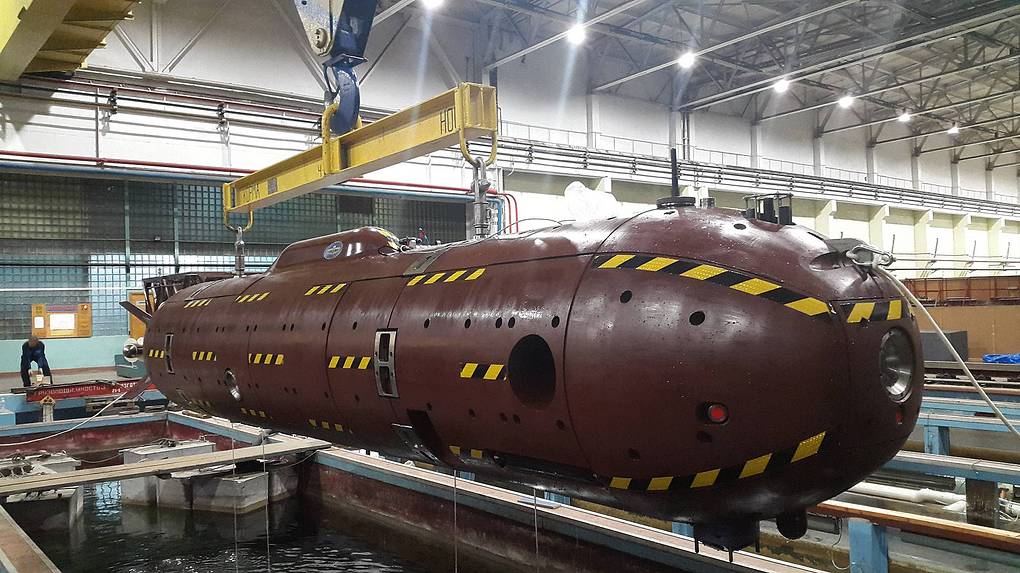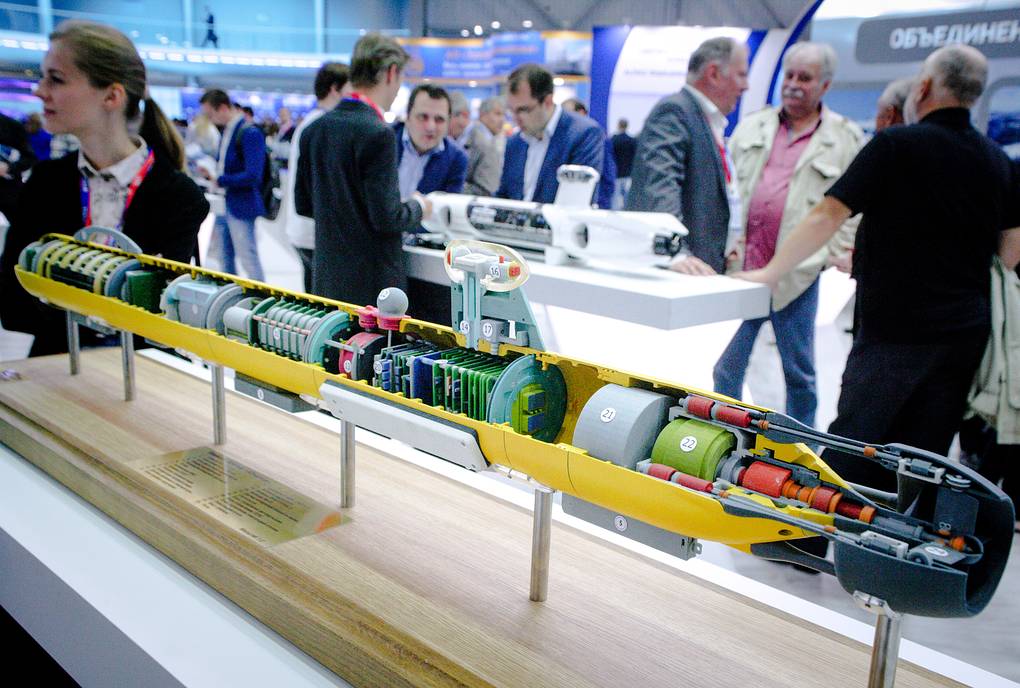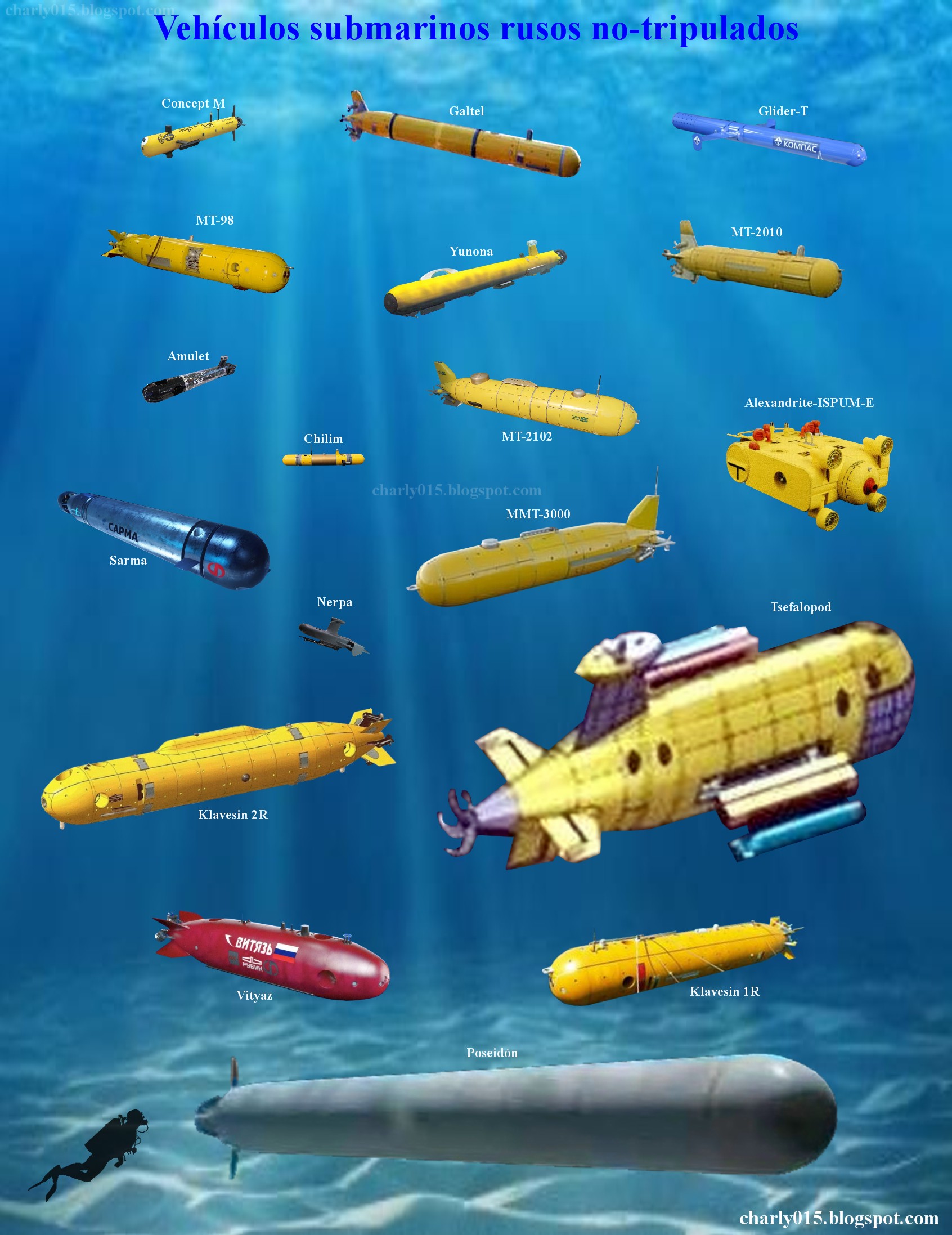The work of the Central Design Bureau MT Rubin in the field of uninhabited underwater vehicles
TASS News Agency June 10, 2020 under the heading "The need for underwater robotics is growing." What sea drones are being created in the Russian Federation ?, published an interview with Igor Vilnit, Director General of TsKB MT Rubin JSC (St. Petersburg), on work in the field of uninhabited underwater vehicles.
 The complex of autonomous uninhabited underwater vehicles "Klavesin-2R-PM" developed by JSC TsKB MT Rubin :copyright: JSC TsKB MT Rubin
The complex of autonomous uninhabited underwater vehicles "Klavesin-2R-PM" developed by JSC TsKB MT Rubin :copyright: JSC TsKB MT Rubin TASS was told about the development prospects of underwater uninhabited vehicles, their unique capabilities and which devices will soon conquer the seas and oceans at the Central Design Bureau MT Rubin, one of the world leaders in the design of submarines and the leading design bureau of underwater shipbuilding in Russia.
The first robot to reach the deepest point of the World Ocean, the bottom of the Mariana Trench in the Pacific, on May 9, 2020, was the Russian autonomous uninhabited underwater vehicle (ANPA) Vityaz-D. The depth of immersion was 10,028 m.
He became the fifth of the devices that ever reached the "bottom of the Earth." But, unlike the Kaiko (Japan) complexes that worked in this area in 1995 and Nereus (USA) in 2009, ours functioned completely autonomously.
Russian Deputy Prime Minister Yuri Borisov has already called this event an outstanding achievement of the Russian defense industry and science, stressing that "a new research and development elite of the defense industry complex will grow on the implementation of just such projects." The Vityaz deep-sea UAV was created by the Rubin Central Design Bureau for Marine Engineering (TsKB MT) (as part of the United Shipbuilding Corporation) in conjunction with the Advanced Research Foundation (FPI).
"The market for underwater vehicles is actively developing" Large-scale work in the field of creating marine robotic complexes and systems for various purposes has been carried out by Rubin in the interests of the Ministry of Defense of the Russian Federation since the beginning of the 1990s. A fundamental feature of the functioning of such technical means is the ability to solve tasks in extremely aggressive conditions of the marine environment in the entire range of depths of the World Ocean in all its regions - from the southernmost latitudes to the North Pole.
“At present, Rubin is working on the creation of robotic systems based on light AUVs - Juno and Amulet. A major step in the bureau’s activities was the deployment in 2013 of the creation of a promising AUVA complex of the Klavaysin-2R-PM project . Complexes of heavy and superheavy AUVs are being developed that are designed to solve a number of complex complex tasks of both research and defense applications, "said Igor Vilnit, Director General of the Rubin Central Design Bureau in an interview with TASS.
The competencies of the enterprise in this area are constantly expanding, he assured. The great scientific potential and accumulated practical experience of the team allow us to offer innovative, high-tech design and production solutions for creating uninhabited deep-sea equipment.
According to Vilnit, the main directions in the creation of underwater robotics are to increase the autonomy of vehicles, the development and further improvement of automatic control algorithms using artificial intelligence elements, the development and production of the necessary materials, devices, and components capable of working at great depths.
“As for the serial production of AUVs, this question is more likely for potential customers of underwater equipment. In many industries, various underwater vehicles are currently used, the need for underwater robotics is increasing,” said Igor Vilnit.
Underwater vehicles "Juno" and "Amulet" were repeatedly shown at the Naval Salon in St. Petersburg, the military-technical forum "Army" and other specialized exhibitions. According to Vilnit, they aroused the genuine interest of various organizations and departments both for carrying out research and practical applications when conducting inspection work for underwater pipelines, communications and underwater structures.
“Given the price / quality ratio of the underwater vehicles produced by TsKB MT Rubin, as well as the presence of a number of unique technical features, I think that our AUVs are quite competitive in the foreign market,” he said.
The market for underwater vehicles is now developing mainly due to the offer of imported remote-controlled vehicles, Vilnit believes. According to him, the advantage of Rubin is that they are offered devices of their own production, created mainly using domestic components and materials. The head of the enterprise calls another important advantage of the Rubin Central Design Bureau - design and manufacture of not just autonomous or telecontrolled devices, but the creation of marine robotic systems (RTOs), which include uninhabited devices, communication and control equipment, delivery and basing facilities, and simulators and training tools for operating personnel.
“When creating marine robotic systems, various methods and devices for the interaction of vehicles with various types of carriers of both underwater and surface class are also being developed. Considering that most of the work on creating mine action systems is carried out on the instructions of the Ministry of Defense, of course, the details of the ROC data are not for wide publication, ”says Igor Vilnit.
However, it is known that a robot is being created that can simulate any submarine. The Rubin developed a concept project for the Surrogate marine robotic complex. As TASS previously reported, the modular design will allow changing its functionality - it can simulate both a nuclear and nuclear submarine, as well as conduct terrain mapping and reconnaissance.
“At present, the Surrogat R&D carried out by us on an initiative basis has been completed. The results of this work have been brought to the attention of relevant organizations of the Ministry of Defense of the Russian Federation, consultations are ongoing,” Vilnit noted.
To develop the Arctic shelf, the Iceberg project was created. "It has been fully completed and accepted by the customer - FPI. The further implementation of the project is currently being carried out in two main areas, which are identified as priority. The first is the creation of a full-scale prototype of an underwater complex of robotic seismic exploration based on the use of a group of seismic-recording AUVs and AUV-emitter of seismic "The second is the creation of a prototype demonstrator of an underwater robotic drilling module," Vilnit says. "The work is carried out as part of the innovative development program of the Central Design Bureau MT Rubin, in coordination with USC. Work in other areas will be organized later, after identifying funding sources."
See the "bottom of the earth"In May of this year, another unique Rubin robot became known - the Vityaz-D drone, which became the first fully autonomous uninhabited underwater vehicle in the world to reach the deepest point in the oceans. Work on its creation began in 2017.
According to the developers, the complex includes an autonomous uninhabited underwater vehicle (AUV) and a sonar bottom station (GDS). The main tactical and technical characteristics of ANPA SGP (super-deep dives): length - 5.7 m; diameter - 1.4 m; weight - 5600 kg; the maximum immersion depth is 12,000 m. The GDS has similar technical characteristics.
The ANPA SPS “Vityaz-D” complex is designed to perform surveying and research tasks in the bottom layer and on the ground of the World Ocean in the entire depth range (up to 12,000 m) and to develop technologies for creating promising complexes of uninhabited underwater vehicles for operating in extreme conditions depths of immersion.
"One of the most important tasks of the complex is also the development of technologies for the manufacture and operation of complex robotic systems at extreme depths," says Vilnit.
“The main difficulties in creating the complex were related to ensuring the operability of devices and mechanisms under the influence of huge hydrostatic pressure,” says the head of the enterprise. “Therefore, when creating elements of hull structures, strong containers for placing equipment, systems and devices, the entire scientific and technical potential of the Central Design Bureau MT Rubin, the entire experience of creating habitable underwater equipment, as well as leading scientific organizations of the industry. "
“When designing and manufacturing, the specialists of our company widely used the most advanced methods of 3D modeling, calculating finite element models, conducted a large number of experiments to confirm the operability of the equipment and the strength of structural elements when exposed to maximum hydrostatic pressure,” says Igor Vilnit.
The development of the documentation was carried out according to the “paperless” technology, and the manufacture of components was carried out on numerically controlled machines (automated robotic machines that can perform operations on a given program without the direct involvement of a person, - note TASS), he adds.
Rubin notes that such autonomous devices operate using an on-board control system that implements control algorithms without human intervention. “In preparation for work, the operator enters the task program for the implementation of a specific mission, after which the device sinks into the water and begins to operate autonomously under the program. At the same time, it transfers various information to the operator’s console via the sonar communication channel,” explains the head of Rubin.
During the ANA tests, the control panels are staff of the Central Design Bureau MT "Rubin" and enterprises - the developer of the control system. “To train operators in operating organizations, our company offers the creation of integrated simulators that provide operators with sustainable practical management skills and a large amount of theoretical knowledge for operating AUVs,” says Vilnit.
About the future of underwater roboticsAccording to the head of the Rubin Central Design Bureau, in the near future there will be a deep integration of robotic means with various classes of carriers - submarines, surface ships providing ships.
"The performance of work using manned technical means - underwater vehicles, especially in deep-sea areas, in the water column and on the bottom of the oceans is inextricably linked with the risk to the life of the operating personnel. The use of robotic systems based on autonomous and remote-controlled underwater vehicles allows you to remove a person from the zone increased risk and provide a more complete and comprehensive picture of the current situation for the effective completion of the task, "he says.
The scientific and technological groundwork at Rubin and the wide experience of practical activity, according to Vilnit, make it possible to offer potential customers the creation of promising high-tech robotic complexes based on heterogeneous uninhabited vehicles.
"In the long run, the bureau specialists have outlined the creation of a global network consisting of a large number of underwater deep-sea vehicles, light-class AUVs, gliders, underwater lighting equipment, UAVs, communications equipment and other components providing for large-scale scientific and research missions," he says .
"The main vectors of the development of underwater robotics now are to increase the autonomy of ANPA swimming, increase the range and accuracy of positioning underwater, as well as further improve algorithms and control principles based on network algorithms, integrate heterogeneous technical and communications equipment into a single complex," said Igor Vilnit .
"The application of network principles for creating complex robotic complexes, modern and promising technical solutions, new programming methods and algorithms will allow in the future to create systems that provide navigation, communication and control of heterogeneous robotic complexes operating in the depths of the oceans, in the open sea and in the airspace, “The Rubin general director Vilnit says at the end of the conversation.“ This will allow the creation of unified control centers for uninhabited underwater, surface and air vehicles, and provide the relevant organizations and departments with complete navigation and technical information in real time. ”
 Model of the underwater vehicle "Juno" :copyright: Ladislav Karpov / TASS
Model of the underwater vehicle "Juno" :copyright: Ladislav Karpov / TASS ANPA "Vityaz-D" after sinking to the bottom of the Mariana Trench in the Pacific :copyright: Press Service of the Advanced Research Foundation
ANPA "Vityaz-D" after sinking to the bottom of the Mariana Trench in the Pacific :copyright: Press Service of the Advanced Research Foundation ANPA Vityaz-D on the deck of the Pacific Fleet rescue ship Fotiy Krylov :copyright: Press Service of the Advanced Research Foundation
ANPA Vityaz-D on the deck of the Pacific Fleet rescue ship Fotiy Krylov :copyright: Press Service of the Advanced Research Foundationhttps://bmpd.livejournal.com/4054787.html













